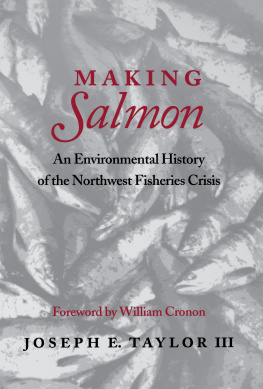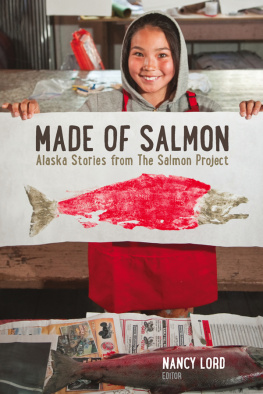Where the Salmon Run
The Life and Legacy of Billy Frank Jr.
Where the Salmon Run
The Life and Legacy of Billy Frank Jr.
TROVA HEFFERNAN


2012 by Office of the Secretary of State
First paperback edition, 2013
Printed and bound in the United States of America
Book design by Veronica Seyd
Cover design and cover photo by Laura Mott
17 16 15 14 13 5 4 3 2 1
All rights reserved. No part of this publication may be reproduced or transmitted in any form or by any means, electronic or mechanical, including photocopy, recording, or any information storage or retrieval system, without permission in writing from the publisher.
Library of Congress Control Number 2012934508
ISBN 978-0-295-99340-9

Washington State Heritage Center
Office of the Secretary of State
P.O. Box 40222
Olympia, WA 98504-0222, USA
www.heritagecenter.wa.gov
University of Washington Press
PO Box 50096
Seattle, WA 98145, USA
www.washington.edu/uwpress
The paper used in this publication is acid-free and meets the minimum requirements of American National Standard for Information SciencesPermanence of Paper for Printed Library Materials, ANSI Z39.481984.
FOR SUGAR, TANU, AND WILLIE
IM DEDICATED TO MY CHILDREN... AND NOT ONLY MY CHILDREN BUT EVERYBODY ELSES. WITHOUT MY FAMILY... I COULDVE NEVER DONE ANY OF THIS.
BILLY FRANK JR.
Contents
Preface
From time immemorial, the original inhabitants of the Pacific Northwest have been recognized as eloquent orators. Written documents and records, however, can be lacking. To capture the contribution of the subject, Where the Salmon Run: The Life and Legacy of Billy Frank Jr. relies on oral history interviews with the Nisqually elder and those who know him best. Conversations with family, allies, and onetime combatants illuminate a divisive chapter on the rivers of this region and a story of the salmon that continues to this day. This book is told largely from the perspective of Billy Frank Jr. and other tribal leaders. It is in no way a comprehensive history of the fish wars or the co-management of natural resources that followed.

Where the Salmon Run
The Life and Legacy of Billy Frank Jr.

Prologue
Spawning salmon will not go unnoticed. The fish travel saltwater highways of the ocean and transform into something of a spectacle. Their bodies turn varying shades of red. Their noses curve into hooks and large swells form on their backs. Approaching death, their once healthy bodies deteriorate. The fish die and a new cycle of life begins.
Salmon are miracles of the ocean, crossing for years thousands of treacherous miles along the West Coast of North America. They are well equipped for the journey. Muscular bodies and caudal fins can lift the fish to unbelievable heights. They clear waterfalls and swim against ocean currents and river flows. Salmon can smell a single drop in 250 gallons of water. This keen sense of smell guides the fish back to their spawning grounds, where they carefully bury their eggs in gravel nests. But out of a thousand eggs, only a fraction of adult salmon will survive the journey.
For all their strength, salmon cannot overpower the ravages of humans and the seeds of development, which have wreaked havoc on their environment. To live, salmon depend on cool, clean water and secure stream banks. Deteriorating habitat and overfishing have devastated runs. International vessels and fleets have intercepted huge numbers of fish. Dams have blocked passages to spawning grounds. Turbines have disoriented the salmon and marked them as easy prey. Early logging robbed the water of shade and nutrients, leaving behind a dirty residue that spreads through streams like a moving cloud, threatening salmon eggs.
For every mile the salmon have traveled, Billy Frank Jr. has taken a step. He has swallowed his pride, let go of the past, and formed the unlikeliest of alliances to ensure that salmon survive. The person who had to walk the farthest is Billy Frank, attests Bill Wilkerson, a former director of the Washington State Department of Fisheries, and he has never stopped.
Ive heard of Uncle Billy my whole life, a Native radio commentator from New York once said. He lives on the water. He knows the earth. If the fish cant live, we cant live. Its that simple.

Introduction
Billy Frank Jr. is a fisherman, and when he dies he hopes thats how history remembers him. He is not a casual angler who passes sunny afternoons away in search of tall tales and kings. Fishing is part of Billys DNA. It dominates his history. It defines his future. Billy has a visceral need to protect salmon and scars to show for his trouble. In a society fascinated by advancing technology, Billy will take you back to nature. He will show you the great rivers where the salmon run, and he will tell you the story of his mysterious fish.
In fact, Billys entire life is rooted in a war over the fish, brutal clashes that reached a fever pitch in the 1960s and 1970s. Havoc on the water aroused the attention of the country. Some even called it the great fish war of the Northwest.
The great fish war did not deal only with salmon. While the state of Washington called the crackdown on Indian fishing conservation, Indians called it racism and an abrogation of a treaty. To Native Americans, fishing is a sovereign right. They ceded land to the U.S. government, but they never gave up their right to the fish. They reserved this right in a treaty and depended on the promise made by Isaac Stevens, superintendent of Indian Affairs: I will write it down in the treaty that you and your people have the right to take fish at these old fishing places, and I pledge the Americans to keep this promise as long as the mountains stand, as long as the sun shines, and as long as the rivers run.
Whites questioned rights that allowed Indians to fish in ways they couldnt. They scornfully labeled Native Americans super citizens and accused them of destroying the runs. The feud on the riverbank raised powerful questions about the definition of Indian treaties and promises between nations.
DECADES AGO, in a far different America, a federal Indian movement swept the country. Unknown fishermen held up their treaties and took a stand. One was a Nisqually Indian named Billy Frank. I wasnt the Billy Frank that I am now, the Nisqually tribal leader told reporters in 1984. I was a bitter person. Says friend Tom Keefe, When I look at Billy Frank, and I guess I know more about him than most people, I can say there is a guy who decided that he could change the world by changing himself.
AT EIGHTY-ONE YEARS OLD, Billy wears his long gray hair in a ponytail and carries a message of perseverance around the world. Leaders of every persuasion hear the story of the Indians from an Indian who knows. My people are still here! he tells them again and again and again.
Next page








